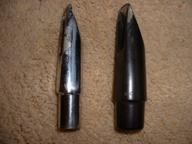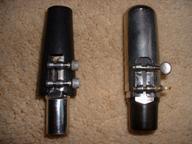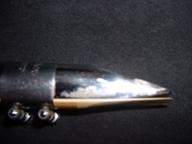

|
SaxophoneMan.com |

|
All Things Saxophone |
|
Equipment Fundamentals — Mouthpieces |
|
Last modified 09/12/08
|
|
Questions or comments? Send us an email |

|
Aside from the saxophonist himself/herself, the saxophone mouthpiece is the component that has the greatest effect on the sound produced from the instrument -- even more than the saxophone. A good portion of the mouthpiece selection process is personal preference, but there are some things the aspiring saxophonist should know when choosing a mouthpiece. There are three main factors that affect the sound that a mouthpiece will produce. They are (in no particular order of precedence) material the mouthpiece is made of, lay, and chamber size. These are discussed as follows: 1. Material the mouthpiece is made of Mouthpieces are made of hard rubber, metal, or (more cheaply) plastic. When a metal and hard rubber mouthpiece with similar lay and chamber size are compared side by side, in general the metal mouthpiece will produce a sharper, brassier tone, and the hard rubber mouthpiece will produce a softer, warmer tone. Plastic is used for student model mouthpieces and for anyone that just wants a cheap mouthpiece. To date, no one has developed a plastic that has the malleability of hard rubber or metal. Plastic has "memory" -- it wants to go back to it's original shape. This can cause warping of the mouthpiece, so plastic is not the material of choice for most mouthpiece manufacturers. 2. The "lay" of the mouthpiece The lay of the mouthpiece is the taper of the mouthpiece from the point where the reed breaks contact with the moutpiece surface to the greatest distance between mouthpiece and reed -- the tip. The lay defines the size of the gap between mouthpiece and reed at the tip of the mouthpiece, and in general the larger the gap the bigger the sound produced. Having said that however, there are limitations to gap size. Too much gap can make the sound brackish and uncontrollable. Most mouthpiece manufacturers gauge the lay of their mouthpiece using a number like 5,6,7, etc. where a larger number represents a larger gap. For some manufacturers a "*" is used to represent a size in between two number sizes (i.e. a 5* is more open than a 5 but less open than a 6). The lay of a mouthpiece has an impact on the strength of reed that the player will choose. 3. Chamber size The chamber is the hollowed out cavity inside the mouthpiece. Mouthpieces typically come in large, medium, and small chambers, where the smaller chamber produces a sharper, edgier sound and the larger chamber produces a smoother, darker sound. Manufacturer markings for chamber size do vary a bit. For example, Meyer uses S,M, & L but Berg Larsen uses 0,1 & 2 to represent small medium and large chambers. For a Meyer mouthpiece the marking 7S means a more open (size 7) lay and a small chamber. A comparable Berg Larsen marking would be 120/0 (120 being a more open lay and 0 being a small chamber). Other factors Manufacturers are always experimenting with other mouthpiece parameters to come up with the latest innovation in saxophone mouthpieces. I have a Runyon on my Tenor that has a "spoiler" which is a metal reed inside the mouthpiece chamber that supposedly resonates and produces more sound. I don't know if makes any difference but I like the sound I get out of it. Some manufacturers have made mouthpieces with adjustable chambers. These are novel but I have yet to see one with a practical application. The ones I have tried just make the player's sound more difficult to control. As innovations are presented to the saxophone community, I will review them and post my comments on this site. Now that we have explained the basic parameters of a mouthpiece, how do you select one? Part of that decision depends on what type of music the saxophonist will be playing. On my horns, I have two mouthpiece setups. One for legit (classical) playing, and one for jazz. In general the legit mouthpiece is hard rubber, less open and has a larger chamber and the jazz mouthpiece is metal, more open and has a smaller chamber. Yes, I know there are many other music styles besides legit and jazz, but for the purposes of choosing a mouthpiece setup other styles can be placed into either the jazz category or the legit category. Here's a table that gives you an idea of what I’m talking about:
|
|
These will almost always apply and in the instance of a style that crosses over you can decide a mouthpiece setup on a case by case basis. There is a standing argument in the world of all things saxophone as to whether or not only ONE mouthpiece setup is needed for any style. I will address this in a later article. Mouthpiece care OK, you have a mouthpiece, how do you take care of it? Mouthpieces are quite durable -- they have little sensitivity to ambient temperature or humidity changes. About the worst thing you can do to a mouthpiece is DROP IT, especially on a hard surface. Dents or chips in the wrong place on a mouthpiece, hard rubber or metal, could make the mouthpiece unplayable in an instant. I once dropped my Beechler 6 (what a great alto sax mouthpiece it was) and chipped a big chunk off it! It was immediately nothing but garbage. At $150 - $400 apiece (for the good ones), saxophone mouthpieces are worth taking care of. Now to address a point of care that is at best awkward and at worst just gross. Over time, mouthpieces experience an accumulation of . . . well, let's just call it "cheese". Too much cheese in the chamber of your mouthpiece can affect the way it plays. Swab out the cheese on a regular basis and this will never be an issue for you. I recommend once a month or so whether it needs it or not (LOL). Also, you can reduce cheese accumulation by avoiding eating and drinking (except water) while playing saxophone. It should go without saying that you don't want to be blowing s__t through your horn, but after 30 years of gigging, recording and teaching you would be amazed at what I have seen. Mouthpiece refacing There are folks that “reface” mouthpieces to improve the sound. There is a standing controversy over whether this is a viable practice. Read the article on mouthpiece refacing for more information. Mouthpiece caps They come in different colors and sizes! How exciting! Seriously, none of that flash really matters. The mouthpiece cap exists to protect the mouthpiece and ligature in storage, and also to protect the reed and help keep it moist when the horn is on the stand or in your lap between charts. All you really need is a cap that fits the mouthpiece snugly enough to seal, but not so tightly that you run the risk of chowing the reed when you put it on. Some manufacturers provide a cap with the mouthpiece and some don't. If you don't have one or you lose the one that came with the mouthpiece, check out the plastic ones at the local music store and you will probably find one that fits your mouthpiece. Unless of course it's a streamlined metal mouthpiece, in which case you've got to get a replacement cap like the one that the manufacturer provided. The aspiring saxophonist who keeps these concepts in mind will have great success in selecting a mouthpiece that is “just right”. |

|
A metal mouthpiece and a hard rubber mouthpiece |

|
A mouthpiece with a plastic mouthpiece cap and one with a metal mouthpiece cap — any similarities to sci-fi movie characters are purely coincidental |

|
A metal mouthpiece with a large lay |
|
Style |
Legit Mouthpiece |
Jazz Mouthpiece |
|
Rock |
|
X |
|
Funk |
|
X |
|
Celtic |
X |
|
|
Contemporary |
X |
|
|
Praise & Worship |
X |
|
|
Latin |
|
X |